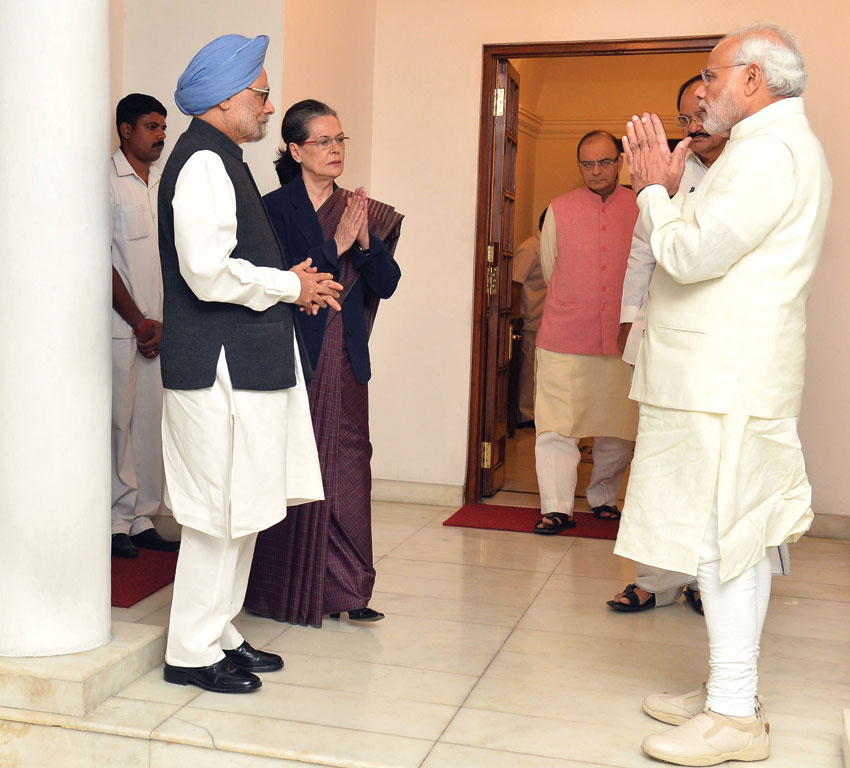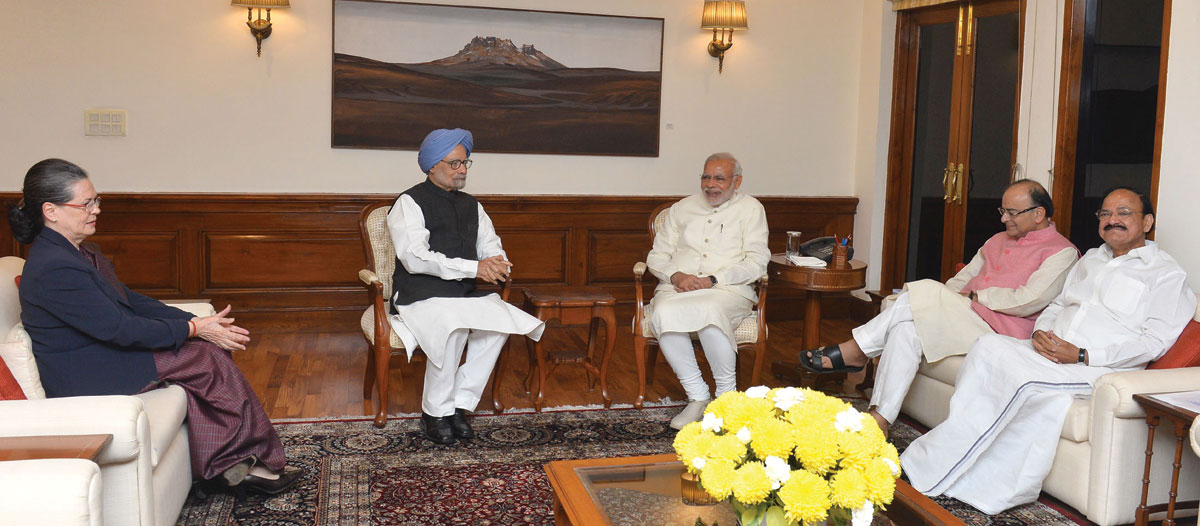PUSHING ECONOMIC REFORMS
Prime Minister Narendra Modi meeting the former Prime Minister, Dr. Manmohan Singh, and Congress President Sonia Gandhi, in New Delhi on Nov. 27. Union Minister for Finance, Corporate Affairs and Information & Broadcasting, Arun Jaitley, and Union Minister for Urban Development, Housing and Urban Poverty Alleviation and Parliamentary Affairs, M. Venkaiah Naidu, are also seen. (Press Information Bureau)
Following the crushing defeat in the Bihar assembly elections, the Indian government has re-focused attempts to push forward economic reforms, the key electoral promise of Prime Minister Narendra Modi. In a rare move to evolve a consensus on the passage of the Goods & Service Tax (GST) bill in the Rajya Sabha, Modi has invited Congress President Sonia Gandhi and former Prime Minister Manmohan Singh, to discuss the matter over tea at his official Race Course Road residence, writes Siddharth Srivastava. (@narendramodi, #siliconeer, @siliconeer, current affairs, politics)
This was the first one-to-one meeting between Sonia and Modi, who have otherwise been at loggerheads and make it a point to avoid each other, inside the Lok Sabha and during public events.
There is an expectation now that the GST bill that industry considers vital for future growth will be enacted with a few changes, with the Congress and other opposition parties coming on board.
Meanwhile, in another move that is expected to bolster the economy, New Delhi has announced the opening of several key sectors including defense, construction, civil aviation and media to foreign investment, eased norms for businesses such as single-brand retail and private banking and allowed Foreign Investment Promotion Board to clear proposals of much higher value.
At a press conference, finance minister Arun Jaitley said, “FDI is an additionality of resources and it is required if the cycle of economic activity has to take off.” Jaitley said outdated norms have been removed and many more areas have been put on automatic route.
“Most important is the construction sector. There has been a slowdown here. Now that interest rates have started easing, the sector will hopefully pick up. The restrictions on capital, area and lock-in period have been highly liberalized,” he said.
In a comment, economist Lord Meghnad Desai said, “This will be important for economic reforms. It’s good that government started early on reforms process.” In a note, Deloitte Haskins and Sells said, “This changes are certainly a move to give higher impetus to the growing economy and will provide an increased level of trust in the system and policy-making apparatus.”

Many, however, see the Modi government’s attempts to revive India’s power sector as its singular reform effort so far. India’s power and coal minister Piyush Goyal has said the execution of Uday, the recently announced revival package of state-run distribution companies or discoms that are saddled with Rs. 4.3 trillion debt, will lead to annual savings of Rs. 1.8 trillion and wipe out the accumulated losses of Rs. 3.8 trillion by FY 2018-19.
Speaking at an investors meet in Mumbai, Goyal said almost all states have welcomed the new initiative. “It is a bottom-up approach, not a top-down approach. The states will be assisted and ‘hand-held’ to bring down the cost of power by improving discoms distribution, transmission and sub-transmission network, reducing the cost of power through coal rationalization and also bringing down the interest cost substantially,” Goyal said.
“Tariff hike is no substitute for improving efficiency. Regulators cannot pass on inefficiency of discoms to consumers,” he added. In a related note, India Ratings has estimated that there could be an annual interest saving of Rs. 250 billion by discoms, if one assumes 50% debt is restructured under Uday.
“This scheme offers the discoms a chance to break out of the decade-old vicious cycle of operational losses being funded by bank debt by transferring debt to state governments, reducing aggregate technical and commercial (AT&C) losses and lowering of the gap between average cost of supply and average revenue per unit,” the agency said. “Thus, the focus of the mission is on improving internal efficiencies of the discoms instead of passing on the inefficiencies to consumers by tariff hikes.”
Ujjwal Discom Assurance Yojana or “Uday,” which means dawn in English, involves a massive bailout package for discoms alongside measures to reduce power thefts, align consumer tariff with generation cost and promote energy efficiency.
Under the plan state government’s will be allowed to take over 75% of debt as of September 30 and pay back lenders by selling bonds, without any negative impact on fiscal deficit. For rest 25%, the state electricity boards will issue bonds. Presently, India’s banking sector has a huge exposure to state-run discoms to the tune of Rs. 4.3 trillion in principle and over Rs. 5 trillion if interest and unpaid dues are added. Goyal said that the state-run Power Finance Corporation and Rural Electrification Corporation, with exposure of about $20 billion to discoms, will not be forced to buy the bonds that will be sold in the open market.
No doubt, the defeat of the BJP government in the Delhi and Bihar elections has been a wake-up call. The expectations from Modi, elected on the twin promises of growth and governance, are high. New Delhi has done well to push the recent reforms.
However, there is a long road ahead. One does hope these changes are not episodic as the road ahead is not easy. With leaders such as Nitish Kumar looking to challenge Modi’s position at the Center, the Indian Prime Minister and his team have their task cut out.


